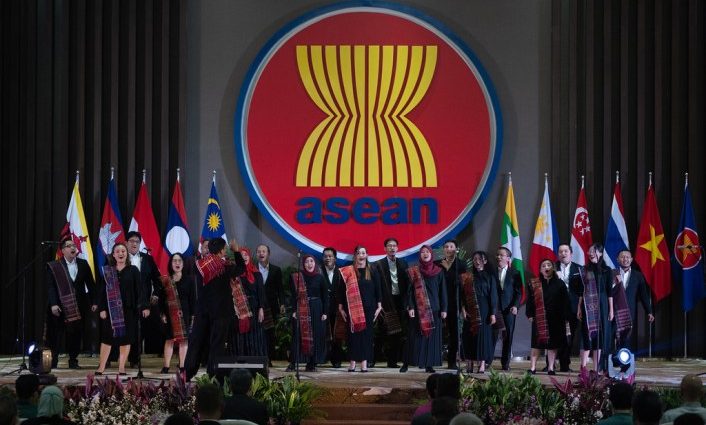Negotiations for the third iteration of the China-ASEAN Free Trade Agreement continued beyond June 2023. Of the three issues highlighted by Chinese Deputy Commerce Minister Wang Shouwen, green economy and supply chain management are of compelling importance.
They offer major opportunities for liberalizing trade in environmental goods and services and further strengthening ASEAN’s vital linkages in its value chain with China. But the third issue identified by Wang Shouwen — the development of the digital economy — has raised some alarm bells for ASEAN negotiators and others.
Digital trade is broadly defined as all trade that is digitally-ordered or digitally-delivered and now accounts for roughly a quarter of international commerce. It continues to grow and it holds the key to future global productivity growth.
But as preferential free trade agreements proliferate, with 116 currently in existence, and each with different e-commerce provisions, the risk of disruptive fragmentation in digital trade as divergent rules to manage data availability and protection emerge is growing.
The present cocktail of FTAs is at risk of transforming into a digital potage of zeroes and ones, with China-ASEAN adding to the confusion.
The particular danger with digital alignment between China-ASEAN is that it will add restrictiveness to existing confusion as the rules governing cross-border data movement come to be modeled on those that have been set by China.
For Beijing, data-protection laws such as the Data Security Law, the Cybersecurity Law and the Personal Information Protection Law, enshrine control over access to data implemented through localization requirements.

These requirements, strengthened in 2021 and again in June 2023, prevent foreign-based companies operating in China from sending Chinese client data or product test information to their head offices for analysis.
In the World Trade Organization’s (WTO) 2021 Trade Policy Review of China, a number of members expressed concern at the very wide definition of national security invoked in Beijing’s digital data management.
ASEAN nations may need little persuasion to follow China’s lead. Vietnam has already adopted some of Beijing’s methods of data localization, prompting concerned US business groups to write to Prime Minister Pham Minh Chinh in September 2022. Cambodia and Indonesia are also moving towards tighter data localization.
The cost of restrictions to digital data flows can be very high and potentially greater than physical trade impediments given the flux in digital technology.
The OECD estimates that, in a country sample where China is by far the most restrictive, a 0.1 point reduction in data restriction is associated with a 145% increase in overall exports. They also find that the impact of digital connectivity in reducing trade costs is now three times higher than it was in 1995.
ASEAN nations may find themselves at the center of tensions over digital infrastructure and digital rules by entering a bilateral deal with China.
For example, Indonesia, the Philippines and Singapore are all linked to a new subsea fiber optic cable called Apricot, being built for Google and Meta, that also links Guam, Japan and Taiwan. Apricot was built deliberately to avoid the South China Sea.
Nonetheless, China still has to be engaged in the development of digital technology and rules. This could be achieved within a broader negotiating framework, such as the Comprehensive and Progressive Agreement for Trans-Pacific Partnership (CPTPP), of which China is an aspiring member and which would oblige Beijing to permit freer cross-border data flows.
This could also bring the United States back into the fold. Yet given congressional antipathy, the United States is very unlikely to seek to join the CPTPP and even less likely to back China’s bid for membership.
There is another forum for engaging China in the promotion of digital trade. This is the WTO Joint Initiative on e-commerce, chaired by Australia, Japan and Singapore, which strives for greater international convergence on provisions that enable and promote cross-border data flows.
Importantly, the WTO Joint Initiative includes both the United States and China within its 89 members, providing a valuable opportunity for US-China cooperation. This WTO initiative also includes Brunei Darussalem, Indonesia, Laos, Malaysia, Myanmar, the Philippines and Thailand.

A particularly timely objective for the co-chairs is to promote the concept advanced in 2019 by former Japanese prime minister Shinzo Abe on Data Free Flow with Trust.
This approach, now attracting interest among governments and academic experts, would be far removed from what Beijing would likely seek to impose within the China-ASEAN Free Trade Agreement.
In negotiating with Beijing, ASEAN undoubtedly risks being dominated by its bigger partner, but the rewards of closer integration make that a risk worth taking – particularly when it is attenuated by the possibility of engaging China multilaterally.
Ken Heydon is a former Australian trade official and senior member of the OECD secretariat, and Visiting Fellow at the London School of Economics and Political Science.
This article was originally published by East Asia Forum and is republished under a Creative Commons license.

